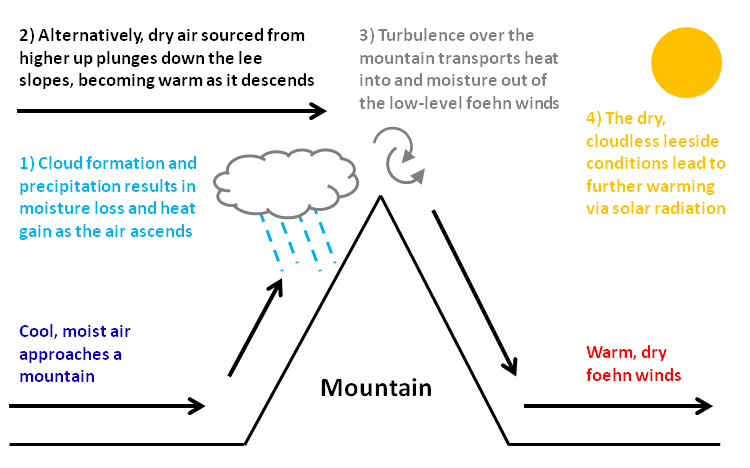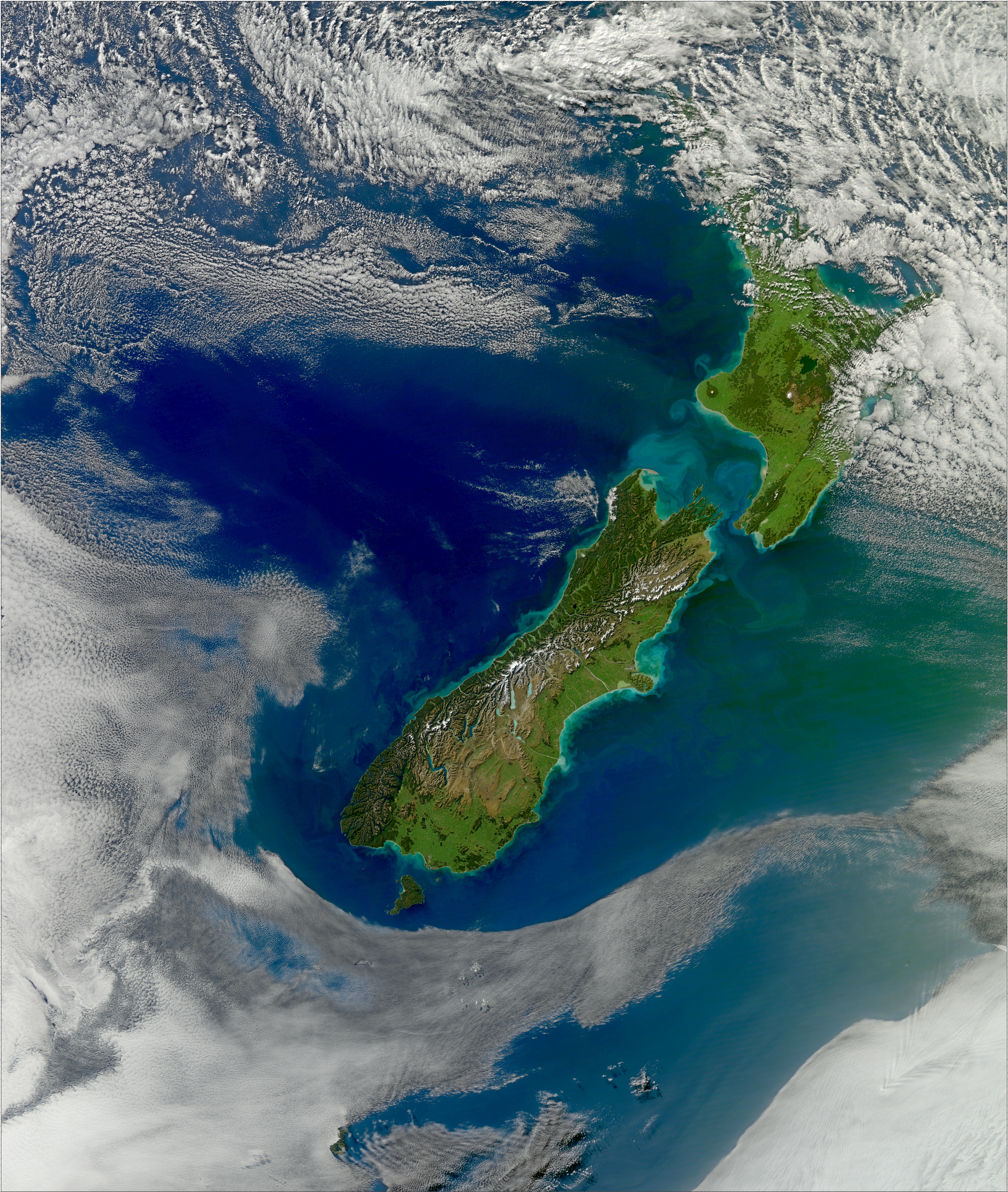|
Nor'wester (New Zealand)
The nor'west arch is a band of high white lenticular cloud that forms on the eastern side of New Zealand's South Island and which looks like an arch in an otherwise clear blue sky over the Southern Alps. It is accompanied by a strong hot northwesterly or northerly wind known as a "nor'wester". In Canterbury Region, Canterbury, where it is a well known feature, it is also called the Canterbury arch. It also occurs in Otago and Marlborough District, Marlborough and east of mountain ranges along the east coast of the North Island. Closer to the Canterbury coast, some distance from the mountains of the Southern Alps, it appears as a clear area of blue above the mountains, with white cloud streaming to the east from it. The phenomenon is similar to the Chinook wind, Chinook arch seen in the Pacific regions of the United States and Canada. Formation The nor'west arch is a föhn cloud or a lenticular cloud. The northwesterly wind drives warm moist air from over the Tasman Sea, and i ... [...More Info...] [...Related Items...] OR: [Wikipedia] [Google] [Baidu] |
Amberley, New Zealand
Amberley is a town located in the Hurunui District in north Canterbury Region, Canterbury, on the east coast of the South Island of New Zealand. It is located on New Zealand State Highway 1, State Highway 1 approximately 50 km north of Christchurch. It is the seat of the Hurunui District Council. The nearest town to the north of Amberly via State Highway 1 (New Zealand), state highway one is Waipara (11 km) and the nearest town to the south is Leithfield (5.7 km). History Amberley was established in 1864 by Mrs. Frederica Josephine Carter who owned freehold land north of the Kowai River, Kowai river. Mrs. Carter subdivided and sold her pastoral run for eight pounds per quarter acre. This price was very attractive as it made the land some of the cheapest in Canterbury. The town was named Amberley after Mrs. Carter's family farm in Oxfordshire, England. The earliest residents included a blacksmith, a wheelwright and a carpenter. A courthouse was established in 187 ... [...More Info...] [...Related Items...] OR: [Wikipedia] [Google] [Baidu] |
Taieri Pet
The Taieri Pet is a lenticular cloud formation that occurs in the Strath-Taieri region of Otago in the South Island of New Zealand. The cloud formation is created when north-westerly winds are forced upwards over the Rock and Pillar Range. The Rock and Pillar Range lies almost perpendicular to the direction of the prevailing north-westerly Foehn wind. The range is steep-sided and has a flat top. Lenticular clouds form when strong northwesterly winds flow up and over the mountain range, creating a standing wave. The air cools as it rises, and the water vapour in the air condenses to form clouds. The Taieri Pet cloud formation can sometimes appear in layers and has been described as a "huge stack of plates" in the sky. The cloud is a common feature in the skies near town of Middlemarch, New Zealand, Middlemarch in the Strath-Taieri, a large glacial valley and river plateau in inland Otago. A Landsat 8 satellite image taken on 7 September 2024 showed the Taieri Pet as an elongated ... [...More Info...] [...Related Items...] OR: [Wikipedia] [Google] [Baidu] |
Roaring Forties
The Roaring Forties are strong westerlies, westerly winds that occur in the Southern Hemisphere, generally between the latitudes of 40th parallel south, 40° and 50th parallel south, 50° south. The strong eastward air currents are caused by the combination of warm air being displaced upward from the Equator towards the South Pole, Earth's rotation, and the scarcity of landmasses to serve as windbreaks at those latitudes. The Roaring Forties were a major aid to ships sailing the Brouwer Route from Europe to the East Indies or Australasia during the Age of Sail, and in modern times are favoured by Yachting, yachtsmen on round-the-world voyages and competitions. The boundaries of the Roaring Forties are not consistent: the wind-stream shifts north or south depending on the season. The strong and continuous winds in the Roaring Forties make this zone advantageous for wind power in places such as New Zealand and Tasmania. Similar but even stronger conditions that occur at more so ... [...More Info...] [...Related Items...] OR: [Wikipedia] [Google] [Baidu] |
Southeast Australian Foehn
The points of the compass are a set of horizontal, radially arrayed compass directions (or azimuths) used in navigation and cartography. A '' compass rose'' is primarily composed of four cardinal directions—north, east, south, and west—each separated by 90 degrees, and secondarily divided by four ordinal (intercardinal) directions—northeast, southeast, southwest, and northwest—each located halfway between two cardinal directions. Some disciplines such as meteorology and navigation further divide the compass with additional azimuths. Within European tradition, a fully defined compass has 32 "points" (and any finer subdivisions are described in fractions of points). Compass points or compass directions are valuable in that they allow a user to refer to a specific azimuth in a colloquial fashion, without having to compute or remember degrees. Designations The names of the compass point directions follow these rules: 8-wind compass rose * The four cardinal directi ... [...More Info...] [...Related Items...] OR: [Wikipedia] [Google] [Baidu] |
Lee Waves
In meteorology, lee waves are Earth's atmosphere, atmospheric stationary waves. The most common form is mountain waves, which are atmospheric internal gravity waves. These were discovered in 1933 by two German glider pilots, :de:Hans_Deutschmann, Hans Deutschmann and Wolf Hirth, above the Giant Mountains. They are Frequency, periodic changes of atmospheric pressure, temperature and orthometric height in a Air current, current of air caused by vertical displacement, for example orographic lift when the wind blows over a mountain or mountain range. They can also be caused by the surface wind blowing over an escarpment or plateau, or even by upper winds deflected over a thermal updraft or cloud street. The vertical motion forces periodic changes in speed and Boxing the compass, direction of the air within this air current. They always occur in groups on the Windward and leeward, lee side of the terrain that triggers them. Sometimes, mountain waves can help to enhance precipitation a ... [...More Info...] [...Related Items...] OR: [Wikipedia] [Google] [Baidu] |
Neil Cherry
Neil James Cherry (29 September 1946 – 24 May 2003) was a New Zealand environmental scientist. Biography Early life and family Cherry was born in Christchurch on 29 September 1946. His parents were James Conrad Cherry and Mona Hartley, who had married in 1940. Cherry could trace his ancestry back to the '' Cressy'', one of the First Four Ships that started the settlement of Canterbury. Cherry was educated at Christchurch Technical College, and went on to study physics at the University of Canterbury, graduating BSc(Hons) in 1969 and PhD in 1971. His doctoral thesis, supervised by R.G.T. Bennett and G.J. Fraser, was titled ''A study of wind and waves''. In 1968, Cherry married Gae Denise Miller, and the couple went on to have two children. Career Cherry specialised most recently in the effects of electromagnetic radiation on human health, following his earlier work in meteorology and wind energy. Politics At the he stood for the Labour Party in the Christchurch elect ... [...More Info...] [...Related Items...] OR: [Wikipedia] [Google] [Baidu] |
New Zealand Geographic
''New Zealand Geographic'' is a bi-monthly magazine founded in 1989 and published by Kōwhai Media of Auckland, New Zealand. In the format popularised by ''National Geographic,'' it focuses on the biodiversity, geography, and culture of New Zealand, Antarctica, and nearby Pacific Islands. The magazine showcases documentary and editorial photography, and each year runs a national Photographer of the Year competition. History ''New Zealand Geographic'' was founded in 1988 by Kennedy Warne and John Woods, and the first issue was Jan-Feb 1989. Warne, who served as editor for 15 years, had a Master's degree in marine biology, which informed the magazine's early focus on conservation and natural history. He was followed in 2004 by Warren Judd as editor. In the July–August 2008 issue, the editor announced the formation of a New Zealand Geographic Society, renamed in the next issue to the New Zealand Geographic Trust, with all subscribers counted as members. It announced its first re ... [...More Info...] [...Related Items...] OR: [Wikipedia] [Google] [Baidu] |
Drought
A drought is a period of drier-than-normal conditions.Douville, H., K. Raghavan, J. Renwick, R.P. Allan, P.A. Arias, M. Barlow, R. Cerezo-Mota, A. Cherchi, T.Y. Gan, J. Gergis, D. Jiang, A. Khan, W. Pokam Mba, D. Rosenfeld, J. Tierney, and O. Zolina, 2021Water Cycle Changes. In Climate Change 2021: The Physical Science Basis. Contribution of Working Group I to the Sixth Assessment Report of the Intergovernmental Panel on Climate Change [Masson-Delmotte, V., P. Zhai, A. Pirani, S.L. Connors, C. Péan, S. Berger, N. Caud, Y. Chen, L. Goldfarb, M.I. Gomis, M. Huang, K. Leitzell, E. Lonnoy, J.B.R. Matthews, T.K. Maycock, T. Waterfield, O. Yelekçi, R. Yu, and B. Zhou (eds.)]. Cambridge University Press, Cambridge, United Kingdom and New York, NY, USA, pp. 1055–1210, doi:10.1017/9781009157896.010. A drought can last for days, months or years. Drought often has large impacts on the ecosystems and agriculture of affected regions, and causes harm to the local economy. Annua ... [...More Info...] [...Related Items...] OR: [Wikipedia] [Google] [Baidu] |
Hurricane
A tropical cyclone is a rapidly rotating storm system with a low-pressure area, a closed low-level atmospheric circulation, strong winds, and a spiral arrangement of thunderstorms that produce heavy rain and squalls. Depending on its location and strength, a tropical cyclone is called a hurricane (), typhoon (), tropical storm, cyclonic storm, tropical depression, or simply cyclone. A hurricane is a strong tropical cyclone that occurs in the Atlantic Ocean or northeastern Pacific Ocean. A typhoon is the same thing which occurs in the northwestern Pacific Ocean. In the Indian Ocean and South Pacific, comparable storms are referred to as "tropical cyclones". In modern times, on average around 80 to 90 named tropical cyclones form each year around the world, over half of which develop hurricane-force winds of or more. Tropical cyclones typically form over large bodies of relatively warm water. They derive their energy through the evaporation of water from the ocean ... [...More Info...] [...Related Items...] OR: [Wikipedia] [Google] [Baidu] |
Radio New Zealand
Radio New Zealand (), commonly known as RNZ or Radio NZ, is a New Zealand public service broadcaster and Crown entity. Established under the Radio New Zealand Act 1995, it operates news and current affairs station, RNZ National, and a classical music and jazz station, RNZ Concert, with full government funding from NZ On Air. Since 2014, the organisation's focus has been to transform from a radio broadcaster to a multimedia outlet, increasing its production of digital content in audio, video, and written forms, utilising rnz.co.nz and the RNZ app. The organisation plays a central role in New Zealand public broadcasting. The New Zealand Parliament fully funds its AM network, used in part for the broadcast of parliamentary proceedings. RNZ has a statutory role under the Civil Defence Emergency Management Act 2002 to act as a "lifeline utility" in emergencies. It is also responsible for an international service, RNZ Pacific, which broadcasts to the South Pacific in both ... [...More Info...] [...Related Items...] OR: [Wikipedia] [Google] [Baidu] |
Gale
A gale is a strong wind; the word is typically used as a descriptor in nautical contexts. The U.S. National Weather Service defines a gale as sustained surface wind moving at a speed between .National Weather Service Glossary s.v "gale" Forecasters typically issue s when winds of this strength are expected. In the , a gale warning is specifically a maritime warning; the land-based equivalent in National Weather Service ... [...More Info...] [...Related Items...] OR: [Wikipedia] [Google] [Baidu] |





